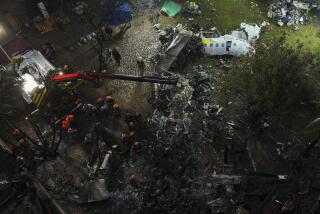51 Years Later, He Learns Brother’s Fate : World War II: Brazilian Army jungle unit discovers wreckage of B-24, missing since 1944. James Leitch says he’s glad uncertainty is over.
- Share via
For James K. Leitch, 51 years of uncertainty have finally come to an end.
Forensic experts from the Army’s Central Identification Laboratory in Hawaii have confirmed what he has suspected since World War II--that a B-24 bomber believed carrying his brother and nine other airmen went down in the Brazilian jungle and all on board were killed.
“It still bothers me,” said Leitch, 70, a retired marketing executive living in Oakhurst, in the foothills of the High Sierra. “But I’m glad it’s over.”
Back in April, 1944, Leitch was a 19-year-old infantryman at Camp Stoneman--a temporary Army base near Antioch--waiting for transfer to the Pacific war zone, when he was summoned to the office of his company commander. “He told me I had leave,” Leitch said.
Leitch said he rushed south to the West Los Angeles home of his parents--William and Rachael Leitch.
“My mother was crying,” he said. “They told me that my brother, John, had been reported missing. That was all they had heard.”
In the months that followed, the Army Air Corps told the Leitch family that Staff Sgt. John Leitch, 22, had been serving as flight engineer on a four-engine Liberator bomber during a ferry flight from the Caribbean island of Trinidad to the Brazilian city of Belem, near the mouth of the Amazon River, on April 11, 1944.
The Army said a routine radio message was received from the plane as it headed inland over a largely unexplored area of the Brazilian jungle. After that, silence.
A month after the plane disappeared, a Brazilian man told local officials he had seen the wreckage of a four-engine plane and several bodies in the jungle. But the man disappeared after making the report, and repeated searches failed to turn up a trace of the bomber.
“No evidence has been submitted that any of the crew parachuted to safety,” the Army said in a report quoted by The Times in 1949. “Nor has any indication been received that the men were found by natives.”
“And that was all that we heard,” Leitch said.
In December, unknown to Leitch, soldiers of the Brazilian Army’s 3rd Jungle Infantry Battalion stumbled onto the wreckage of a large plane in the Amapa jungle, about 250 miles from Belem. The soldiers sent back a wrinkled piece of leather that appeared to have been torn from a flight jacket similar to those worn by World War II bomber crews.
On July 4, Leitch’s wife, Helen, was scanning a newspaper when she spotted a three-paragraph wire story about the wreckage found in the Brazilian jungle.
“She asked me, ‘Could this be John’s plane?’ ” Leitch said. “I knew it was.”
Leitch said he made numerous phone calls before reaching military officials who told him that the forensic team was setting up excavation equipment at the jungle crash site. The first two weeks of digging with hydraulic mining gear yielded little.
“They had dug several meters deep and were starting to lose hope when, suddenly, they started finding bones, rings, necklaces and dog tags with names and ranks written on them,” Fernando Allegretti, a spokesman for the Amapa international affairs department, told the Associated Press.
Allegretti said one investigator found a wallet containing family photos, and another found several 1944 dollar bills.
Leitch said the searchers have confirmed the identity of the plane and its crew roster, but he has not been told whose dog tags were recovered or received word that the victims have been positively identified from the teeth and bone fragments recovered at the site.
“They told me that the plane was 150 miles off course,” he said. “They don’t know why it went down, but it could have run out of gas. They feel that the whole crew was killed on impact.”
More to Read
Sign up for Essential California
The most important California stories and recommendations in your inbox every morning.
You may occasionally receive promotional content from the Los Angeles Times.













